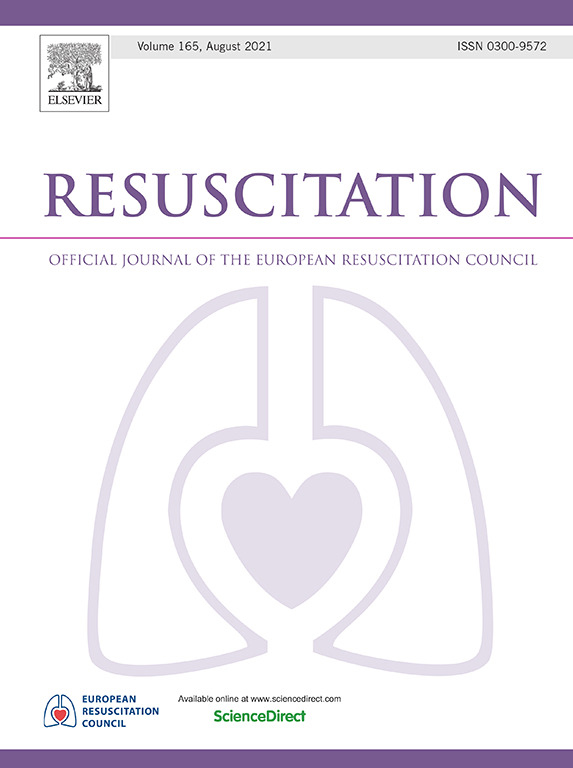院前ECPR治疗难治性心脏骤停- PRECARE试点可行性研究
IF 4.6
1区 医学
Q1 CRITICAL CARE MEDICINE
引用次数: 0
摘要
背景:传统心肺复苏(CCPR)治疗难治性院外心脏骤停(OHCA)的生存率仍然很低。体外心脏复苏(ECPR)越来越多地用于难治性OHCA,其结果受建立ECMO流量之前心脏骤停持续时间(低流量时间)的影响。院前ECPR旨在减少低流量时间。院前医生可能是能够提供ECPR的工作人员,增加了获取和可持续性。方法:院前医师实施院前ECPR单臂开放标签可行性试验。年龄在70岁以下的患者,有明显的崩溃,最初的休克性心律,并且在移动团队45分钟的半径范围内,有资格进行院前ECPR。一旦建立体外支持流,患者被运送到三个ECMO能力中心之一。主要目的是评估院前ECPR在这种情况下的可行性。结果:从2023年8月到2024年6月,在103个招募日期间,院前ECPR团队共治疗了123例确认的心脏骤停,12例(10%)患者接受了院前ECPR,相当于每8个班次1例。所有患者在心脏骤停时均在现场成功插管。从派遣到团队到达的平均时间为18.5分钟(范围9-29);从决定到ECMO流量的平均时间为17 min(范围10-34),平均总低流量时间(骤停到ECMO流量)为39 min(范围24-56)。4例(33%)患者成功摆脱VA ECMO支持,3例(25%)患者存活至出院时神经功能完好(CPC 1-2)。结论:经院前培训的院前医疗团队进行院前ECPR分娩是可行的,可减少OHCA低流量次数。需要更大规模的研究来评估疗效和成本效益。本文章由计算机程序翻译,如有差异,请以英文原文为准。
Pre-hospital ECPR for refractory cardiac arrest – The PRECARE pilot feasibility study
Background
Survival from refractory out of hospital cardiac arrest (OHCA) treated with conventional cardiopulmonary resuscitation (CCPR) remains low. Extracorporeal cardiac resuscitation (ECPR) is increasingly be utilised in refractory OHCA, with outcomes influenced by the duration of cardiac arrest prior establishing ECMO flow (low flow time). Pre-hospital ECPR aims to reduce the low flow time. Pre-hospital physicians may represent a workforce who could deliver ECPR, increasing access and sustainability.
Methods
A single-arm open-label feasibility trial of pre-hospital ECPR delivered by pre-hospital physicians. Patients under the age of 70 years with a witnessed collapse, an initial shockable rhythm and within a 45-minute radius of the mobile team were eligible for pre-hospital ECPR. Once extracorporeal support flow was established, patients were transported to one of three ECMO capable centers. The primary aim was to assess the feasibility of pre-hospital ECPR in this setting.
Results
From August 2023 to June 2024, over 103 recruitment days, the pre-hospital ECPR team attended 123 confirmed cardiac arrests, 12 (10%) patients received pre-hospital ECPR equating to one case per 8 shifts. All patients were successfully cannulated on scene while the patient was in cardiac arrest. The mean time from dispatch to team arrival was 18.5 min (range 9–29); mean time from decision to ECMO flow was 17 min (range 10–34) and the mean total low flow time (arrest to ECMO flow) was 39 min (range 24–56). Four (33%) patients were successfully liberated from VA ECMO support, 3 (25%) patients survived to hospital discharge neurologically intact (CPC 1–2).
Conclusions
Pre-hospital ECPR delivery by trained pre-hospital medical teams is possible and reduces OHCA low flow times. Larger studies are required to assess efficacy and cost effectiveness.
求助全文
通过发布文献求助,成功后即可免费获取论文全文。
去求助
来源期刊

Resuscitation
医学-急救医学
CiteScore
12.00
自引率
18.50%
发文量
556
审稿时长
21 days
期刊介绍:
Resuscitation is a monthly international and interdisciplinary medical journal. The papers published deal with the aetiology, pathophysiology and prevention of cardiac arrest, resuscitation training, clinical resuscitation, and experimental resuscitation research, although papers relating to animal studies will be published only if they are of exceptional interest and related directly to clinical cardiopulmonary resuscitation. Papers relating to trauma are published occasionally but the majority of these concern traumatic cardiac arrest.
 求助内容:
求助内容: 应助结果提醒方式:
应助结果提醒方式:


